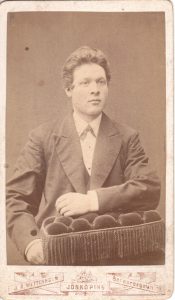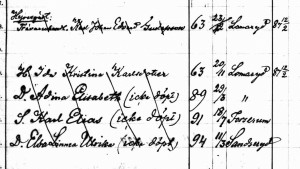I’m still up to my elbows in my big data clean-up but more than halfway done! It feels so good to get my records and source citations in good order. As I’ve been going through my Swedish record collection, I’ve looked at a few documents more closely and of course that prompts me to follow up on leads, and then I get sidetracked from my data clean-up…well, that’s just how it goes with me and genealogy.
It’s worthwhile, though, and I came across some really interesting stuff yesterday!
My great-grandmother Augusta Mathilda Gustafsdotter came to America in 1882 and ended up in Lancaster County, Nebraska at the home of her husband’s uncle, Carl Rudeen. Augusta’s parents were the ones who worked at the Nobynäs estate, which we visited on our trip to Sweden. When Augusta came to America, she left behind her parents and two younger brothers.

One of the photos I picked up at the Johnson Family Reunion was one that had in pencil on the back, “Augusta’s brother”. Sadly, I don’t know which brother this is. It could be the older of the two brothers, Frans Gustaf Gustafsson, who left home in 1885 to work as a Railway Agent at nearby Aneby Station. He later advanced to similar jobs in Flisby and then Linköping. I won’t be able to track him much further because the records end in 1899. Or it could be the younger of the two brothers, Carl Johan Edvard Gustafsson, who left home in 1890 and became a Trävaruhandel which translates as “lumber trader”. He moved to nearby parishes of Forserum and Sandseryd, than off to Skövde up near Skara where again, the published records come to an end.
Both brothers married and had at least three children each.
But here’s what’s REALLY interesting. Both brothers refused to have their children baptized! It says right in a record for Carl Johan Edvard’s oldest daughter, “fadder har vägrat låta döpa barnet” which I assume to mean “father has refused to baptize the child”. For both families, the parish pastor made special note next to all the children that they were not baptized.

What does THAT mean? Based on a little bit of digging, I think the best conclusion might be that these families were part of a non-Lutheran church movement. They could have been Baptists or members of some other type of Free Church denomination. Actually, the Free Church is a good possibility; I understand that freely-chosen adult baptism is one of the tenets of their church. Augusta herself joined the Swedish Mission Church (later Evangelical Covenant Church) with her husband Gust Rudeen upon their arrival in America.
We recently found out that my great-grandfather Christian Pearson (on my mom’s side of the family) was buried in a cemetery founded by a Swedish Baptist Church in Weston, Nebraska. Whether he truly subscribed to the Baptist articles of faith or whether it was simply the only Swedish Church available I do not know. Still, it’s interesting to see how religion plays a role in their life choices.
Something else that jumped out at me was that during the period 1876-1880 (right before Augusta came to America), her father’s status on the Skallycke farm changed from Arrendatore (tenant farmer) to Egare (owner). We had always heard that Augusta came from a “higher station” than her husband Gust, and that she “married down”. Maybe this lends credence to that story.
Something ELSE that’s interesting is the prior owner of the Skallycke farm: someone with the last name of Stjerngranat (the Stjerngranat family were the owners of Nobynäs). More on that soon!
